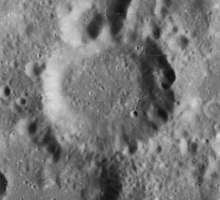Fermat (crater)
Fermat is a lunar impact crater located to the west of the Rupes Altai escarpment. To the west-southwest is the larger crater Sacrobosco, and to the southwest is the irregular Pons. It is 39 kilometers in diameter and two kilometers deep.[1]
 Lunar Orbiter 4 image | |
| Coordinates | 22.71°S 19.79°E |
|---|---|
| Diameter | 37.77 km |
| Depth | 2.0 km |
| Colongitude | 20° at sunrise |
| Eponym | Pierre de Fermat |

The rim of Fermat is worn and somewhat irregular, but still possesses an outer rampart. The north rim is indented by a double crater formation that includes Fermat A. The floor is relatively flat and does not have a central rise.[2] The crater is from the Pre-Imbrian period, 4.55 to 3.85 billion years ago.[1]
It is named for 17th century French mathematician Pierre de Fermat.[3][1]
Satellite craters
By convention these features are identified on lunar maps by placing the letter on the side of the crater midpoint that is closest to Fermat.[4]
| Fermat | Coordinates | Diameter |
|---|---|---|
| A | 21.8°S 19.6°E | 17 km |
| B | 23.0°S 21.1°E | 11 km |
| C | 21.0°S 18.5°E | 14 km |
| D | 20.1°S 18.0°E | 13 km |
| E | 19.9°S 19.9°E | 7 km |
| F | 22.1°S 20.2°E | 5 km |
| G | 19.4°S 20.0°E | 7 km |
| H | 23.1°S 20.7°E | 5 km |
| P | 23.6°S 19.3°E | 37 km |
References
- Autostar Suite Astronomer Edition. CD-ROM. Meade, April 2006.
- Rükl, Antonín (1990). Atlas of the Moon. Kalmbach Books. ISBN 0-913135-17-8.
- "Fermat (crater)". Gazetteer of Planetary Nomenclature. USGS Astrogeology Research Program.
- Bussey, B.; Spudis, P. (2004). The Clementine Atlas of the Moon. New York: Cambridge University Press. ISBN 0-521-81528-2.
